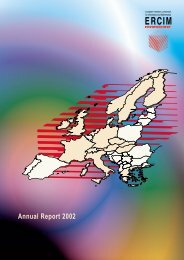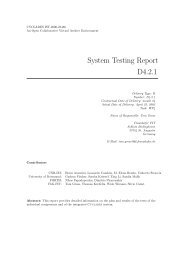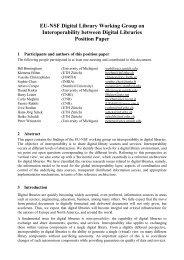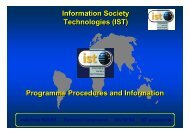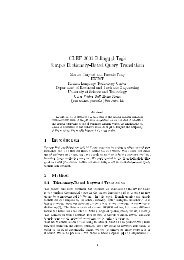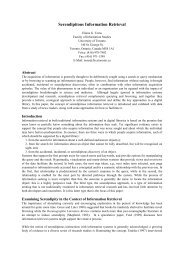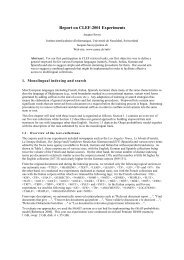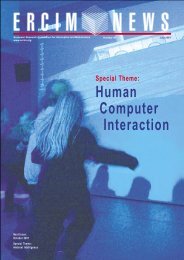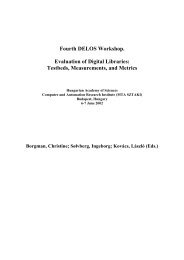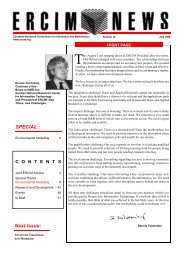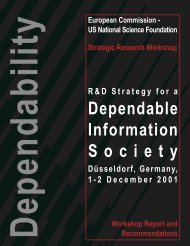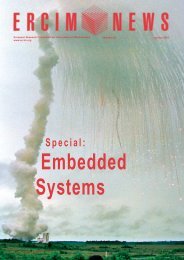Bioinformatics Biocomputing - Ercim
Bioinformatics Biocomputing - Ercim
Bioinformatics Biocomputing - Ercim
You also want an ePaper? Increase the reach of your titles
YUMPU automatically turns print PDFs into web optimized ePapers that Google loves.
RESEARCH AND DEVELOPMENT<br />
Approximate Similarity Search<br />
by Giuseppe Amato<br />
Similarity searching is fundamental in various<br />
application areas. Recently it has attracted much<br />
attention in the database community because of the<br />
growing need to deal with large volume of data.<br />
Consequently, efficiency has become a matter of<br />
concern in design. Although much has been done to<br />
develop structures able to perform fast similarity<br />
search, results are still not satisfactory, and more<br />
Contrary to traditional databases, where<br />
simple attribute data are used, the standard<br />
approach to searching modern data<br />
repositories, such as multimedia<br />
databases, is to perform search on<br />
characteristic features that are extracted<br />
from information objects. Features are<br />
typically high dimensional vectors or<br />
some other data items, the pairs of which<br />
can only be compared by specific<br />
functions. In such search environments,<br />
exact match has little meaning; thus,<br />
concepts of similarity are typically<br />
applied. In order to illustrate this, let us<br />
consider an image data repository. It is<br />
clear that images are not atomic symbols,<br />
so equality is not a particularly realistic<br />
predicate. Instead, search tends to be<br />
based on similarity, because resemblance<br />
is more important than perfectly matching<br />
bit patterns. On the other hand, all that is<br />
similar is not necessarily relevant, so this<br />
paradigm tends to entail the retrieval of<br />
false positives that must be manually<br />
discarded. In other words, the paradigm<br />
rejects the idea that queries may be<br />
expressed in terms of necessary and<br />
sufficient conditions that will determine<br />
exactly which images we wish to retrieve.<br />
Instead, a query is more like an<br />
information filter, defined in terms of<br />
specific image properties, which reduce<br />
the user’s task by providing only a small<br />
number of candidates to be examined. It<br />
is more important that candidates that are<br />
likely to be of interest are not excluded<br />
than it is that possibly irrelevant<br />
candidates be included.<br />
We have investigated the problem of<br />
approximated similarity search for the<br />
range and nearest neighbour queries in<br />
the environment of generic metric spaces.<br />
From a formal point of view, the<br />
mathematical notion of metric space<br />
provides a useful abstraction of similarity<br />
or nearness. We modified existing treebased<br />
similarity search structures to<br />
achieve approximate results at<br />
substantially lower costs. In our proposal,<br />
approximation is controlled by an external<br />
parameter of proximity of regions that<br />
allows avoiding access to data regions<br />
that possibly do not contain relevant<br />
objects. When the parameter is zero,<br />
precise results are guaranteed, and the<br />
higher the proximity threshold, the less<br />
accurate the results are and the faster the<br />
query is executed.<br />
In order to have good quality results an<br />
accurate proximity measure is needed.<br />
The technique that we use to compute<br />
proximity between regions adopts a<br />
probabilistic approach: given two data<br />
regions, it is able to determine the<br />
probability that the intersection of these<br />
two regions contains relevant data objects.<br />
In fact, note that, even if two regions<br />
overlap, there is no guarantee that objects<br />
are contained in their intersection.<br />
research is needed. The performance of similarity<br />
search for complex features deteriorates and does<br />
not scale well to very large object collections. Given<br />
the intrinsically interactive nature of the similaritybased<br />
search process, the efficient execution of<br />
elementary queries has become even more important,<br />
and the notion of approximate search has emerged<br />
as an important research issue.<br />
Evaluation of approximate k nearest neighbours search.<br />
Extensive experimental tests have shown<br />
a high reliability of this approach that<br />
gave a substantial contribution to the<br />
quality of the approximate results and to<br />
the efficiency of the approximate<br />
similarity search algorithm. We applied<br />
this idea for the similarity range and the<br />
nearest neighbours queries and verified<br />
its validity on real-life data sets.<br />
Improvements of two orders of magnitude<br />
were achieved for moderately<br />
approximated search results.<br />
The main contributions of our approach<br />
can be summarised as follows:<br />
• A unique approximation approach has<br />
been applied to the similarity range and<br />
the nearest neighbours queries in metric<br />
data files. Previous designs have only<br />
considered the nearest neighbours<br />
search, sometimes even restricted to<br />
one neighbour.<br />
• The approximation level is parametric,<br />
and precise response to similarity<br />
42 ERCIM News No. 43, October 2000



